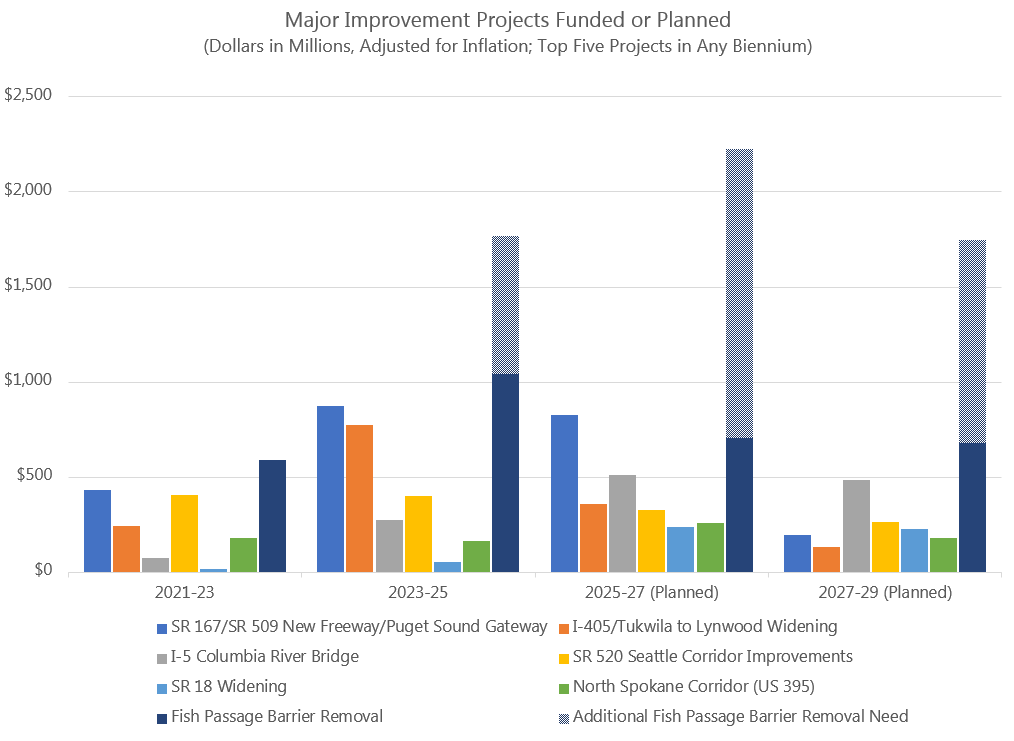2:56 pm
November 20, 2023
The Seattle Times has a troubling report on new estimates of the cost of removing fish passage barriers in Washington.
In 2013, a federal court issued a permanent injunction requiring “the state to significantly increase the effort for removing state-owned culverts that block habitat for salmon and steelhead by 2030.” Since then, the state has increased spending for that purpose. In 2019, the state estimated that it would take a total of $3.796 billion to comply with the injunction (from 2013–15 through 2029–31). The 16-year transportation revenue package enacted in 2022 (Move Ahead WA) set aside $2.435 billion for fish passage barrier removal.
The enacted 2023–25 transportation budget appropriated $1.041 billion from all funds for fish passage barrier removal and plans to spend another $1.886 billion in the future. Based on the 2023–25 budget, including prior and future spending, the state plans to spend a total of $3.946 billion.
However, the Times reports, “The nearly 20-year process to remedy the state’s culverts is now forecast to cost between $7.3 billion and $7.8 billion”—potentially double what is currently planned. With the currently planned spending, “WSDOT expects to have reached 80% of the total habitat. To get the additional 10% it may cost an additional $4 billion.” The following chart shows the amount appropriated or planned for fish passage barrier removal by account. It includes the estimated additional needs as reported by the Times.

In our report on the transportation budget and revenues, we wrote about how costs are increasing for many transportation projects. In general, that’s due to market conditions, labor shortages, fewer bids, and inflation. According to the Times, for culverts, “WSDOT now has a more realistic picture of costs because the agency recently hired HDR, an international engineering firm, to estimate the price of specific construction projects. Previous figures were based on assumed costs, but they didn’t account for each site’s constraints.”
How will the state cover this cost increase? As we showed in our recent report, transportation revenues are expected to decline in inflation-adjusted terms going forward. The Times:
The Legislature could consider delaying highway projects, shifting money from other pots of funds or raising taxes. Lawmakers may be tempted to look to the state’s carbon auctions to cover the costs, which are projected to bring in $2 billion over the next two years.
“We’ve got to look at the revenue and the cash flow and see what we can do,” said Fey. “But certainly there will be delays [to state projects]. And if we don’t have any flexibility those may be substantial delays.”
Fey declined to speculate which projects might be delayed, but the state is set to advertise several large contracts in 2024, including $500 million to widen Highway 18 near Issaquah and $400 million to build the remainder of Highway 167 between I-5 and Puyallup.
Typically, the transportation budget stands apart from the state’s general fund, insulating vital state functions such as health care, children’s services or higher education. But in 2022 budget writers approved a $2 billion transfer to support the Move Ahead package.
The Move Ahead WA package did include more funds from the operating budget than normal. The 2022 budget made a one-time $2 billion transfer from the general fund–state (GFS) to the multimodal account. The Move Ahead WA package also includes annual transfers of $88 million from the GFS to the Move Ahead WA flexible account (for a total of $1.258 billion over 16 years).
As noted above, the spending plan for the Move Ahead WA package includes $2.435 billion for fish passage barrier removal. With the Move Ahead WA funds and federal funds, the state significantly increased spending on barrier removal this biennium. (Note, too, that the state allocated $400 million from its share of the federal coronavirus state fiscal recovery fund to fish passage barrier removal.)
Although the Times suggests that the proceeds from the carbon emission allowance auctions might be a funding source for culverts, that would require a statutory change to the allowable uses of those funds. The portion of the proceeds that are allocated to the transportation budget may only be used for active transportation, transit programs, alternative fuel and electrification, ferries, and rail (RCW 70A.65.240).
If the state uses the Move Ahead WA package to fund the increased costs for removal, it would have to significantly reduce what it is spending on other items. The package currently funds $5.411 billion in climate commitment act projects, but those would not be cut as their funding source cannot be used to replace culverts. There’s also $450 million for debt service, which would not be cut. Setting those aside, the rest of the funded items (including new and existing highway projects and preservation and maintenance) would have to be cut by about 42% to make room for the culvert spending.
The 2023–25 budget includes $1.041 billion for fish passage barrier removal, which is already the most spent on any improvement in the budget. Now, the Times reports that another $725 million is needed this biennium. The next biggest highway improvement projects in the budget are $874 million for the Puget Sound Gateway and $776 million for I-405 widening. The estimated new needs for culverts would substantially exceed spending on the other major projects in each biennium. Additionally, the total amount budgeted for highway improvements in 2023–25 is $4.594 billion. Another $725 million would be a 15.8% increase.

